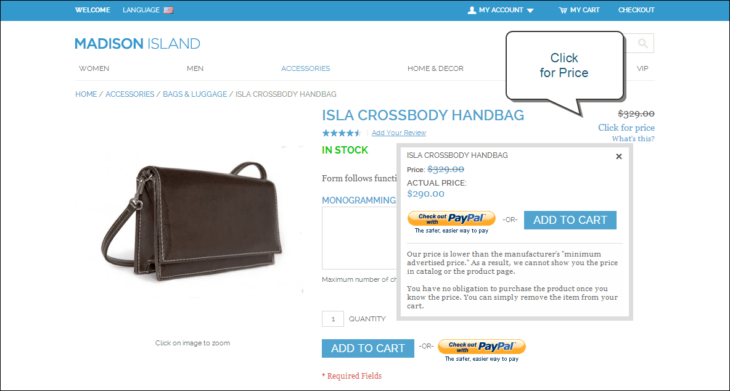Minimum Advertised Price (MAP) is the lowest possible price which retailers can advertise, or print, the stock sold by manufacturers. The minimum advertised price is agreed between the manufacturers and the retailers, and it forbids retailers to sell below that price. The price of the products can still be agreed, as long as it is above the MAP. Retailers can still sell products below that price, but it will result in a couple of things.
Firstly, it will skyrocket the sales for those retailers that sell below the MAP, but it will damage the profits made by the manufacturers. MAP should stay in play mainly for the reason that it mostly damages the manufacturer, not the retailer. The MAP is preventing retailers from gaining a lot of traffic and popularity, in a short time on the market.
With online retailers, new ones emerge every day. And they represent your competition, so it’s natural that the prices for the same products vary from retailer to retailer.

Source: magento.com
10 Reasons Why MAP Should be Monitored
- With more and more retailers advertising the same product, having a fixed MAP in play will protect the profits made by manufacturers.
- Minimum Advertising Price makes it easier to assess the competition.
- It gives manufacturers a clear overview of the price at which their product is being sold on the market.
- If retailers sell the product at a lower price, it will damage the reputation of the brand, as well as, lower the value of the product. Having a fixed MAP price will protect the manufacturers and the product.
- MAP is used to set the standard of the product.
- Selling the product above the MAP makes everyone happy. Manufacturers will not be bothered about the price, as long as it is above the MAP.
- MAP keeps the market in check for retailers that are trying to undersell the product.
- As most retailers, both online and from brick-and-mortar stores, lower the price of products to clear out their inventory, this can be damaging for both parties and MAP prevents that.
- If someone is selling below the MAP, he gets all the profits. Retailers who sell the product above the MAP will only be affected negatively by this.
- Those retailers that do not follow the MAP only risk losing the manufacturer. This is damaging for both retailer and manufacturer.

Source: nuvonium.com
There are a set of pricing policies that manufacturers place in order to ensure that retailers comply with the MAP pricing.
- Manufacturers can visit the retailer’s store, or go online, and check if the item is sold above the MAP.
- Retailers can offer evidence such as screenshots or solid proof to prove that they are compliant with the MAP.
- The manufacturer and retailer can renegotiate the MAP so that both parties can be happy going forward.
- If MAP pricing policies have been signed and the retailer doesn’t comply, then the manufacturer can take legal actions against the retailer. This goes the same with online retail websites like Amazon and eBay.
The Minimum Advertised Price (MAP) ensures the manufacturer that no retailer will undersell their product. This protects the brand and the product itself. But following the MAP is also good for the retailer, as larger profits can be made if selling the product at a higher price than the MAP.
